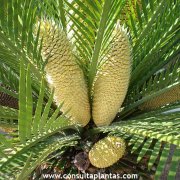Care of the cycad Macrozamia moorei or Cycad palm |
|
The genus Macrozamia, family Zamiaceae, comprises 40 species of cycads native to Australia. Some species are: Macrozamia moorei, Macrozamia communis, Macrozamia johnsonii, Macrozamia fraseri, Macrozamia macdonnellii. Common names: Giant Burrawang, Moore's Cycad, Zamia palm, Cycad palm. This species is native to Australia. They are cycads with a columnar trunk and slow growth that reach 10 meters (32.8 feet) in height and 5 meters (16.4 feet) in width. They have arched leaves composed of dark blue-green leaflets with spines at the base. They produce cones that contain poisonous seeds if ingested. Giant Burrawang is used as isolated specimens in medium or large gardens. It's ideal for Mediterranean coastal gardens. Macrozamia moorei can be grown in full sun, semi-shade or shade exposures. It prefers subtropical or Mediterranean climates. It resists frost down to -7 ºC (19.4 ºF). Moore's Cycad can grow in any type of soil that is well drained. This easy-to-grow, low-maintenance plant is drought-resistant. Water moderately waiting for the substrate to dry. Fertilize with compost in early spring. Cycad palm does not require pruning. Macrozamia moorei is a quite resistant plant to the usual pests and diseases. Giant Burrawang propagates from seeds but it's a very slow process: they take 1-2 years to germinate. |
Images of the cycad Macrozamia moorei or Cycad palm |
Find plants
Macrozamia moorei or Cycad palm | Care and Growing
© 2025 FavThemes






